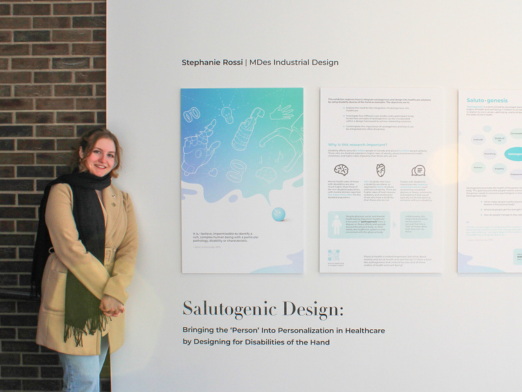MDes graduate centres holistic wellness in healthcare product design
Caitlin Crawshaw - 13 June 2024

Industrial design (ID) is behind the look and function of nearly every product you own, from the smartphone in your pocket to the chair you might be sitting on right now. And if you happen to wear glasses or a prosthetic limb, you can thank ID for these, too.
The discipline is broad in its application, but graduating student Stephanie Rossi (‘24 MDes, ‘21BDes) gravitated to health and wellness early on. “I really like the marriage of art and design with the technical side of things, especially in terms of health,” she says.
Rossi, who completed the U of A’s Bachelor of Design (BDes) program in 2021, took advantage of the program’s flexibility to explore ID applications in health and wellness, including disability and accessibility, and the customization capabilities of technologies such as 3D printing.
“We could tailor projects towards our interests,” she says.
This meant that for a project introducing the business model canvas, Rossi could explore the development of a product addressing mental health concerns like anxiety or ADHD. On another occasion, Rossi was able to research wheelchair design and accessible spaces as part of a furniture-related project.
By the end of the program, Rossi was certain she wanted to work at the intersection of ID and human health and wellness.
After graduating, she spent the summer doing a studentship at the U of A Faculty of Medicine and Dentistry’s Learning Design Studio (formerly Academic Technologies), an interprofessional team that uses design to improve health sciences education.
Rossi worked on a project for Stollery Children’s Hospital that involved finding a way for hospital residents to practice performing pediatric bronchoscopies without the use of the hospital’s very expensive, continuously breaking dummy.
Using data from CT scans of a child’s lungs, Rossi used a 3D printer to create a physical prototype of the airway tunnels. The device, which resembles hollow tree roots, allows residents to practice maneuvering a bronchoscope through the tunnels of the lungs in order to take diagnostic images, samples, and biopsies.
Rossi returned to campus for the Master of Design (MDes) program. “Honestly, I just wasn’t done learning,” she says. For her graduate research, she explored sociologist Aaron Antonovsky’s concept of ‘salutogenesis.’ Unlike conventional models of health that focus on the origins of disease or injury (‘pathogenesis’), ‘salutogenesis’ focuses on the mental, emotional, and social origins of optimal health. This approach had yet to be used in either ID or Western healthcare, she adds.
Rossi applied the concept to hand prosthetics and disability devices of the hand, which are sometimes used by people with congenital limb differences or amputations. Conventional hand prosthetics allow a person to hold and grab objects, enabling basic survival needs like eating and drinking. “But are people actually thriving?” asks Rossi. “What if this person had played tennis before an accident? Or what if someone was born with a congenital limb difference and wanted to play the violin?”
For her graduate project, “Salutogenic Design: Bringing the 'Person' Into Personalization in Healthcare by Designing for Disabilities of the Hand,” Rossi designed prototypes of hand prosthetics that consider a person’s emotional and lifestyle needs, not just survival needs.
As she prepares to cross the stage to receive her MDes, Rossi has been working as an industrial designer for ChromaCare Labs. The Edmonton-based biotech startup is developing novel at-home lab testing kits. She will also be working as a U of A sessional instructor in the fall.
Rossi is excited to find out where her career will lead her. “I really want to keep doing work related to health and wellness, and improving quality of life for people,” she says. “As long as I know I’m doing good for people, I will be happy.”